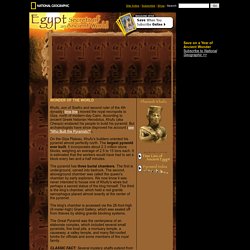

How Were the Egyptian Pyramids Built? No cameras were around thousands of years ago when the ancient Egyptians built the three pyramids of Giza, for each of three pharaohs Khufu, Khafre and Menkaure.

And so scientists have had to piece together clues as to how these towering monuments were constructed. Over the past two decades, a series of new discoveries and studies allowed researchers to paint a clearer picture of those feats. [In Photos: Inside Egypt's Great Pyramids] How did Egyptians build the pyramids? Construction mystery solved after University of Amsterdam wet sand experiment. Scientists say they have finally solved mystery of how the ancient Egyptians built the pyramids.

The world has been baffled for thousands of years about just how slave workers transported the massive blocks across the Valley of the Kings in around 2,000BC. Now physicists have come up with a two word answer after years of calculations - 'wet sand'. Dutch researchers have figured out the Egyptians placed heavy objects on a sledge, pulled by hundreds of workers, and simply poured water on the sand in front of it. Orion, more than a constellation. Orion more than a constellation It’s a global phenomenon.

THE GIZA PYRAMIDS AS A STELLAR REPRESENTATION OF ORION'S BELT. Was It An Iron Meteorite? There has been much talk about symbolic representation and what it means.

Such matters, however, are sometimes best explained by images. Take a look at the two photographs below. Flash! Fox News Reports that Aliens May Have Built the Pyramids of Egypt! Special Report Richard Carrier Volume 23.5, September / October 1999 Pseudoscience as news?

The Fox Network’s handling of its primetime special "Opening the Lost Tombs: Live from Egypt” raises ethical questions. I couldn't believe my eyes. This is how it begins, and it only gets worse. Questionable Sources On the ten o'clock news, after we are told that the pyramids have never been a tomb, correspondent Garcia continues, “Still, modern day scholars debate not only what they are, but why they are-who, or what, built them?”
The Great Pyramid, Giza, Egypt. Pyramid of Snefru at Maidum. Builder of several pyramids, Pharaoh Snefru, secured access to monument-building stone via military victories outside Egypt.

Likely influenced by the Step Pyramid of Djoser, Snefru, the first king of the 4th dynasty (time line), began a seven-level stepped pyramid some 35 miles (56 kilometers) south of Saqqara. By the time his workers had reached the fourth or fifth level, Snefru upped the ante to eight steps. The first Egyptian pyramid with an aboveground burial chamber (just above the first step level), the Maidum tomb may represent an effort to raise the chamber closer to the sun god. Another innovation is the archlike design of the burial chamber's walls. The pyramid was temporarily abandoned 15 years into Snefru's reign—probably when he moved his court north from Memphis to Dahshur. Today only the three highest steps are visible above the shifting sands, fallen debris, and sloping base. NEXT: First Attempt at the Classic Shape >> << Return to Pyramid Index. Great Pyramid of Khufu at Giza. Khufu, son of Snefru and second ruler of the 4th dynasty (time line) moved the royal necropolis to Giza, north of modern-day Cairo.

According to ancient Greek historian Herodotus, Khufu (aka Cheops) enslaved his people to build his pyramid. But archaeologists have since disproved his account (see "Who Built the Pyramids? "). On the Giza Plateau, Khufu's builders oriented his pyramid almost perfectly north. The largest pyramid ever built, it incorporates about 2.3 million stone blocks, weighing an average of 2.5 to 15 tons each. It is estimated that the workers would have had to set a block every two and a half minutes. The pyramid has three burial chambers. The king's chamber is accessed via the 26-foot-high (8-meter-high) Grand Gallery, which was sealed off from thieves by sliding granite blocking systems.
CLASSIC FACT: Several mystery shafts extend from the king's and queen's chambers. NEXT: Home of the Sphinx >> << Return to Pyramid Index. National Geographic. Writer Carl Hoffman traveled to Egypt in February 2011, a week after popular demonstrations led to the president's resignation.

These are his observations. Tourism is Egypt’s second largest source of revenue, bringing in $13 billion in 2010. The Great Pyramid at Giza, after all, is one of the seven ancient wonders of the world. To visit the Pyramids is to be struck dumb by their monumentality, their celebration of the fundamental human need to create.
It's even more affecting in the midst of a revolution, when there are no tourists at all. I have visited them before, but this time they felt different. In the empty quiet I had a chance to talk to the horsemen and camel drivers who usually hustle rides to tourists. “We have no work, nothing,” said Ali Abd el Hamid, astride his camel. He and his colleagues ply their trade seven days a week, year in and year out, a profession inherited from their fathers and grandfathers.